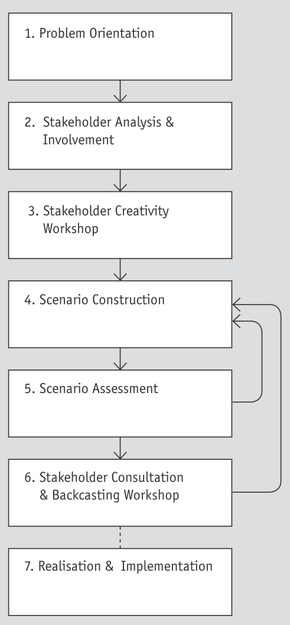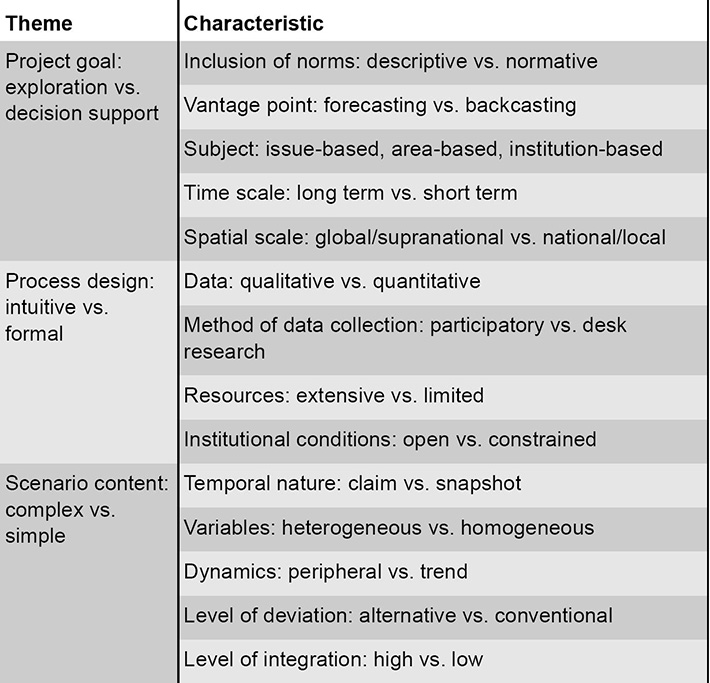Scenario methodology for exploring radical innovation
Exploring the innovation space involves moving around many dimensions from past to future, possible to desirable, everyday activities to innovation opportunities, concepts to solutions, etc. In particular two methodologies are relevant for this endeavour. Scenario methodology explores alternative situations and fits the overall structure of a vision project, while design methodology holds the key to defining, exploring and developing the content within a given situation in time and space. As such the design methodology is an essential aspect of vision projects, but it is assumed that the reader is familiar with design methodology so the following will focus on scenario methodology.
The exploration of alternative futures is commonly associated with scenario thinking:
Scenario thinking is especially developed to deal with complexity and uncertainty. Scenarios are therefore by nature tentative and provisional human constructs rather than historical records. In the methodological realm, they occupy a middle ground in the exploration of the future and typically deal with a time horizon of three to ten years. Scenario thinking is situated in between the analytical, short-term forecasting techniques and the bold statements of visionary gurus. Forecasting can be done with a high level of detail and probability, while the more uncertain and abstract types of visions are highly dependent on the underlying assumptions and the ability to capture the wider context.
Since scenarios became popular in the 1960s, they have found application in an increasing number of sectors and disciplines. Scenarios are now being used by decision-makers, consultants and researchers in a variety of situations which have given rise to a wide range of derivatives of the overall scenario methodology.
Scenario types
Policy-orienting scenarios
The most popular scenario methodology comes from strategic business planning and is focused on reducing complexity in order to reach a consensus and make a management decision. Cornish (2004) suggests a set of five common scenario plots: continuation, optimistic, pessimistic, disaster and transformation. Other approaches propose only two or four scenarios, which are constructed on the basis of a selection of one or two parameters that are considered to be decisive for the future. Such scenario constructs are particularly common in policy-making and mainly serve to instigate action in times when uncertainty is likely to paralyse decision-makers. For example, the two scenarios for an organisation may describe a situation of ‘business as usual’ versus an ‘ideal state’ (Ackoff 1978).
A typical scenario process is structured in the following way (Schwartz 1991):
1. Identify focal question or decision
2. Key forces in the local environment
3. Driving forces
4. Rank by importance and uncertainty
5. Selecting scenario logics
6. Fleshing out the scenarios
7. Implementation
8. Selection of leading indications and signposts
Design-orienting scenarios

Since the late 1990s, there have been some attempts to combine the scenario and design methodologies by leading universities and design consultancies (Evans 2003; DFFN 2003; Rodriquez 2005). The resulting methods have been called ‘future led’, ‘solution’- or ‘design’-oriented but all aim to envisioning concrete opportunities and apply the basic scenario process in a very different way than strategic planning.
Manzini & Jegou (2000) use the term “design-orienting scenarios” (DOS) to describe scenario work which “propose a variety of comparable visions that have to be clearly motivated and enriched with some visible and (potentially) feasible proposals.” (Manzini & Jegou 2000, p.3). The analytical unit of DOS is the physical and socio-cultural context in which actions take place, i.e. everyday activities. All in all, the DOS approach to scenario work aims to develop an innovation map as described in chapter 6, “The Innovation Map“.
After an initial problem orientation and stakeholder analysis, a creative workshop was conducted with stakeholders. The workshop aimed at generating ideas about the future opportunities and clustering these ideas into proto-scenarios. A research team then elaborated the scenarios further, to a point where they subsequently could be assessed in terms of impact on the environment and consumer acceptance. Depending on the result of the assessment the process may either proceed towards realization or back-track to one of the previous steps.
Network-orienting scenarios
The above scenario methodologies are designed to create a limited number of possible scenarios that make decision-making easy. A scenario is originally described as being an end-state and a sequence of events, but the above methods emphasize the end-state and do not explain the sequence of events which lead to the scenarios. Dennis List (2005) aims not only at representing a sequence of events, but also a network of scenarios across various time horizons. In order to map the scenario space a number of techniques are used to explore various sections which are then gradually integrated. The process consists of five stages:
1. Tracing the past through to the present
2. Probing the present
3. Looking ahead from the present
4. Creating morphological paths, and backcasting along them
5. Midcasting: anticipating discontinuities

The creation of an overview of alternatives is a core characteristic of the innovation map and the framework developed by Dennis List is one of few that attempts to do so. Another characteristic of the innovation map is the focus on innovation opportunities and everyday activities. Most scenario work focuses on macro-level factors and most of those who incorporate a micro-level perspective have little insight into the field of design and innovation. However, within the field of design and innovation, there have been attempts in recent years to shape an academic field combining scenario methodology and design.
Scenario characteristics
The development of the scenario methodology has not been coordinated, but in recent years there have been several attempts to create an overview and develop a typology of the many variations. For example, the futurist Masini (1993) distinguishes between descriptive, normative, objective, subjective and systemic scenarios. Inayatullah (2002) mentions four overlapping research dimensions: empirical, interpretive, critical and participatory.
Van Notten (2003) has sought to create an overview and an updated typology of scenarios. The study identified a number of characteristics in relation to three overarching themes: project goal, process design and content.

The overview of scenario characteristics is not so much a matter of either/or but aims to describe the main parameters which must be negotiated in the formulation of the project brief and further elaborated in the course of the scenario process.
Extract from PhD thesis “Everyday-Oriented Innovation”